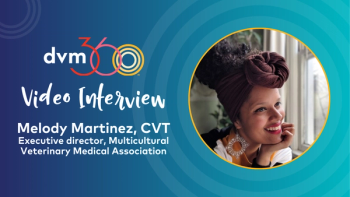
Finding genetic markers
Jenna Dockweiler, MS DVM, DACT, CCRT, CVAT, and Lindsey Kock, DVM, provide some concrete examples of genetic markers that can be found from DNA testing.
Episodes in this series

Sponsored by Embark
Adam Christman, DVM, MBA: Sometimes we as veterinarians may not realize like oh my gosh you can test and see some of these markers, so share some more examples.
Jenna Dockweiler, MS DVM, DACT, CCRT, CVAT: Yeah, absolutely. I always encourage people to think of this in the same way that we do screening blood work in our healthy patients. We're not necessarily expecting something to come up, but when something does we can then create a care plan to treat our patient. So one of the more common mutations that we actually see in our veterinary patients is hyperuricosuria and hyperuricemia, or urolithiasis, which is very mercifully abbreviated HUU. This is urate urinary stones, which is the Dalmatian urinary stone disease, but there are a lot of Pitty mixes out there that are at risk as well. That is an example of a disease that is actually not all that uncommon. It's just that we don't look for it in that population of patients. And potentially, it can be prevented from manifesting altogether If you know about that risk ahead of time. You can make some diet changes, we can do some monitoring with your analyses and urinary ultrasounds to ensure that patient never goes on to develop those stones.
Adam Christman, DVM, MBA: Wow, that's interesting. I know you were just talking about clotting and we historically just tend to think of Von Willebrand's factor as an example but there's other ones that we should be aware of.
Lindsey Kock, DVM: Factor VII deficiency is another one too that affects more breeds than you might think about, right? So, beagles, I mean, that's a huge one that you can be on the lookout for. And you may get to the point of that puppy's spay or neuter and have no idea. I think those are things too that I definitely don't want to find out after the spay or neuter, that first surgical procedure, that there's an issue. So, being able to screen for that ahead of time is a huge deal.
Adam Christman, DVM, MBA: I know we were just talking before we started filming about IVDD and tell them about what we know about with Frenchies with IVDD.
Jenna Dockweiler, MS DVM, DACT, CCRT, CVAT: Sure. So there is a mutation on chromosome 12s called the FGF4 retrogene, and that does increase the risk of type 1 Intervertebral Disc Disease (IVDD) in a variety of different breeds, but it also causes chondrodystrophy, so a kind of short, long-bodied appearance, which is of course popular in many of our breeds, such as Dachshunds and French Bulldogs. Almost all Frenchies have at least one copy of this mutation, meaning that almost all Frenchies will be at increased risk of IVDD as a result of this mutation.
Adam Christman, DVM, MBA: Wow. I mean, it's really good to know that, I think. Especially as veterinarians, we need to know these things, right?
Newsletter
From exam room tips to practice management insights, get trusted veterinary news delivered straight to your inbox—subscribe to dvm360.


















